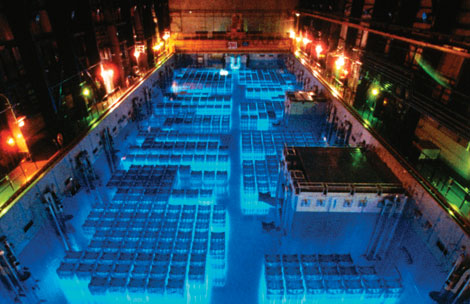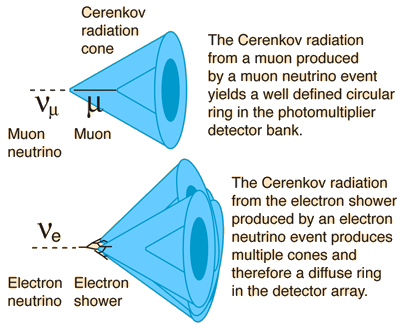Is there an equivalent of the sonic boom for light?
A sonic boom is a shock wave which propagates from an aircraft or other object which is going faster than sound through the air (or other medium). In subsonic flight air is deflected smoothly around the wings. In supersonic flight this cannot happen because the effect of the aircraft wings pushing the air ahead cannot travel faster than sound. The result is a sudden pressure change or shock wave which propagates away from the aircraft in a cone at the speed of sound.Check this :)
It is thought that objects cannot travel faster than c, the speed of light in vacuum (see Relativity FAQ article on FTL travel.). Furthermore there is no ether to act as a medium being pushed aside like the air is pushed by an aircraft. Therefore no light equivalent of the sonic boom can occur in vacuum.
In a medium such as water, the speed of light is considerably less than the speed of light in vacuum. In a medium with refractive index n the velocity of light is vlight = c/n. The refractive index is always greater than one* so it is possible for a particle to travel through water (nwater = 1.3) or other media at a speed faster than the speed of light in that media. When a charged particle does so, a faint radiation is produced from the medium.
The charged particle excites the water molecules which then return to their normal state emitting photons of blue light. Because the particle is moving faster than the speed of light in water, it can trigger a cascade of photons which are in phase with each other and can constructively interfere to form the visible blue glow. The light propagates away in a cone forward of the region where the interaction took place. The half angle of the cone a can easily be derived in terms of the velocity of the particle v by looking at where wave fronts emitted from the track of the particle constructively interfere.
cos(a) = vlight/v
This is analogous to the formula for the angle at which
a sonic boom propagates. The effect known as Cherenkov radiation was observed
as a faint blue glow by Pavel Cherenkov in 1934 when he
was asked to look at the effects of radioactivity in liquids.
The explanation for the light was provided by
Ilya Franc and Igor Tamm. It is possible to detect the
Cherenkov radiation as it forms circles on a surface and can
be used to measure the speed and direction the particle was
travelling in. It is therefore a very useful means of studying
the products of particle collisions and cosmic rays.
The effect known as Cherenkov radiation was observed
as a faint blue glow by Pavel Cherenkov in 1934 when he
was asked to look at the effects of radioactivity in liquids.
The explanation for the light was provided by
Ilya Franc and Igor Tamm. It is possible to detect the
Cherenkov radiation as it forms circles on a surface and can
be used to measure the speed and direction the particle was
travelling in. It is therefore a very useful means of studying
the products of particle collisions and cosmic rays.When highly radioactive objects are observed under water, such as in "swimming pool" reactors and in the underwater temporary spent fuel storage areas at nuclear reactors, they are seen to be bathed in an intense blue light called Cerenkov radiation. It is caused by particles entering the water at speeds greater than the speed of light in the water. As the particles slow down to the local speed of light, they produce a cone of light roughly analogous to the bow wave of a boat which is moving through water at a speed greater than the wave speed on the surface of the water. Another analogy statement is to say that the Cerenkov cone is like a sonic boom except that it is done with light.
 | One of the valuable applications of Cerenkov radiation is in the detection of neutrinos and distintinguishing between different types of neutrinos. An energetic muon remains intact while slowing down and its Cerenkov cone paints out a well-defined circular ring on the detector array. A high energy electron on the other hand will produce a diffuse ring on the detectors because it will produce a shower of electrons, each with its own Cerenkov cone. |
Cerenkov applications |
The blue glow in the water surrounding nuclear reactors is Cherenkov radiation. The water is there to stop neutrons but neutrons are uncharged and do not directly cause the radiation. It actually comes from beta particles (fast electrons) which are emitted by fission products. For most media blue light predominates over longer wavelengths of light because the number of quanta emitted as Cherenkov radiation in a wavelength interval dl at wavelength l over a path length L is given by,
dl (2 pi alpha) L sin2(a)/l2
alpha is the fine structure constant
equal to about 1/137. Notice that the refractive
index, and therefore the angle a also,
changes with wavelength l as
demonstrated when a prism produces a spectrum from
white light. This suppresses the rate at small
wavelengths in the ultraviolet and beyond.Although Cherenkov radiation is indeed a light equivalent of the sonic boom, there are also some essential differences. The sonic shock wave is a non-linear effect of sound propagation whereas light wave propagation is always linear. The way the waves are generated is also quite different.
* Strictly speeking the refractive index is not always greater than one. Indeed, it is almost always less than one for X-rays. This is because the phase velocity of X-rays in a medium is faster than light and the refractive index is the ratio of phase velocities. The speed of photons is the group velocity which is always slower than c (except when it isn't :-). For simplicity we ignore the distinction in this article. See the Relativity FAQ article on faster than light (phase velocity) for an explanation. [Thanks to Pieter Kuiper for pointing this out.]


0 Comments::
Post a Comment
Hope you enjoyed :)